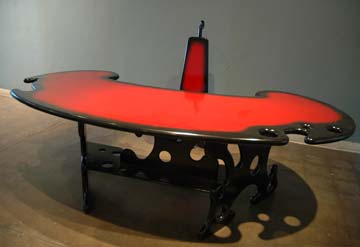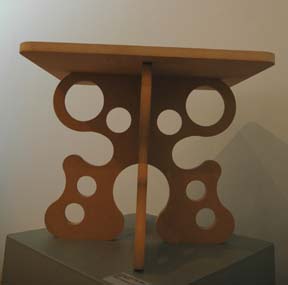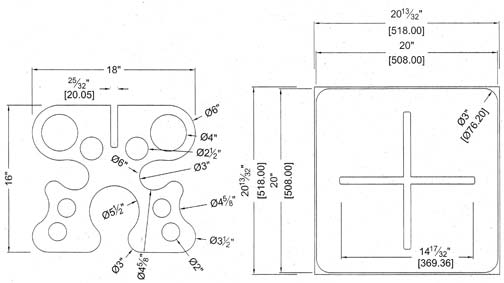|
Vol. 2, Issue #21 November 9th - November 22nd, 2007
A Robot Made My Table
It’s odd to me now, after living here for over four years already, how blank my own mind was about Oklahoma ( or indeed the other “fly over” states). I think most people on the coasts had the same notions, or lack thereof, that I had about this state. I can sum up the entirety of my former knowledge in the following list: Trail of Tears, Land Run, Dust Bowl, Bombing.
And this is because things can actually happen here. I get a lot of disbelief about this from people who grew up here and have never lived anywhere else. I also get it from people who have never been here. But what I get from people who moved here from elsewhere, or people who moved back here after living elsewhere, is TOTAL AGREEMENT. And I think the primary reason for this incredible potential is the people of this state. That’s you (and me). Nonzine is a great example of the kind of open minded willingness to experiment and listen to differing viewpoints that I think has made this such a great place for creative people to be. I encourage you...no,wait, I command you to begin in earnest to pursue your creativity. To develop your talent in whatever discipline has meaning for you. I promise that the road will be both long and hard. But, something I have discovered about Oklahoma, as opposed to other states, is that others will not actively try to push you off the road or block your progress. And if your pursuit has real meaning for others, then you will find meaningful support, as well.
Furniture is, and always has been, just a variety of elevated planes for practical use. Somewhere to put something else that isn’t the ground. Your food (a table), your body (a bed), your bum (a chair), your books (a shelf), whatever. The elevated plane, the surface on which to put things, can be large or small, narrow or wide, high or low. This is usually, but not always a result of the intended use. Everything else, everything else, is design. From the choice of materials (wood, metal, plastic, glass, etc.), to the appearance of the support structure, any other detail besides the location of the usable surface, is a matter of choice. These are decisions made by the designer, the builder, and the user. Sometimes this is all one person, sometimes it is several. We have been making these decisions for millions of years ( this rock or tree stump is more comfortable to sit on than that one), and we’ve gotten pretty good at it. There are books and websites that will tell you what range of measurements are “standard” for such things as the height of a seat or countertop or bed or whatever.
I do want for as many people to have my furniture as possible. Traditionally, this would mean choosing one of my designs to mass produce, get set up for that mass production, produce a whole lot of one thing, and then try to sell them. This is how furniture companies currently work. Technology exists today, and is in current use, to do things in a radically different way. I design for this kind of technological “micro-fabrication”, where things are made as needed, where needed using locally available materials. Come to City Arts Center at state fair park from November 15th through December 22nd and visit the “Illumination” show. You will be able to see my work in the real world, and you can buy “A Robot Made My Table”. Every table purchased will be produced only as ordered. It takes about fifteen minutes to execute the program, so you will have it within twenty four hours, something I can almost never do when making things by hand. You support local artists (me and my programmer Tracy Jones), and get in early on the future of furniture design and fabrication. And one day in the not too distant future, you will be able to completely recycle every part of my furniture, making it “cradle to cradle” instead of “cradle to grave.”
A ROBOT MADE OUR TABLE... Photo By: Clark Deal At an undisclosed location in Oklahoma City is a Giant Robot ( a Biesse Rover 24 CNC router ). Okay maybe it’s not Giant, but it’s a pretty big robot. Furniture maker Hugh Meade (Artifactor Studios) has replaced the fine programs normally executed by the Giant Robot with new “instant table” programs, created from Mr. Meade’s original drawings by his accomplice, the mysterious and possibly mythical Tracy Jones. Order yours today. Soon to be available at select retailers of fine design. The price is $125.00 A Robot Made My Table is an example of “micro-fabrication” as described by Neil Gershenfeld in his groundbreaking MIT class “how to make (almost) anything”. Robots similar to the one that made this table currently reside all over the world, ready at a moment’s notice to receive programming from Artifactor Studios. If someone in Finland would like one of these tables it need not necessarily be produced in Oklahoma City. Instead, it could be created on demand by the Robot nearest to the intended destination. This eliminates the warehousing and most of the shipping associated with traditional methods of manufacturing. Hugh loves to ramble on endlessly about this subject and will use phrases like “cradle to cradle design” and “technical nutrients” and “spimes” as though he really knows what they mean. Enjoy. This particular table is made of MDF (Medium Density Fiberboard) but could be produced from almost any 3/4” sheet material (such as plexiglas or plywood). It is quite durable and functional. More designs will be available as new programs are created.
|
||
©2007 NONCO Media, L.L.C.

 In 2001, my wife and I decided to leave Atlanta. We loved it, but it was just too expensive, overpopulated, and hectic to believe we could really succeed there. Also, we had a child to raise, and wanted to provide the best environment for him to grow up in that we could find. If you had told me then that Oklahoma City was the right place for us to be, I’d have laughed.
In 2001, my wife and I decided to leave Atlanta. We loved it, but it was just too expensive, overpopulated, and hectic to believe we could really succeed there. Also, we had a child to raise, and wanted to provide the best environment for him to grow up in that we could find. If you had told me then that Oklahoma City was the right place for us to be, I’d have laughed. I didn’t exactly have mis-conceptions about Oklahoma, I simply had no conceptions whatsoever on which to base a valid opinion. But once I visited with my family, for three days in June 2002, I knew this was the place. The place where I would establish myself as a world recognized designer. The place where I could begin the company which will change the history of object design and the future of manufacturing on a global scale.
I didn’t exactly have mis-conceptions about Oklahoma, I simply had no conceptions whatsoever on which to base a valid opinion. But once I visited with my family, for three days in June 2002, I knew this was the place. The place where I would establish myself as a world recognized designer. The place where I could begin the company which will change the history of object design and the future of manufacturing on a global scale. Furniture Theory 101
Furniture Theory 101 I design and build furniture which pleases my own sense of what is attractive. What I make by hand takes me many lonely hours in a workshop to complete. It is, therefore, quite expensive (relative to mass production) to own one of these pieces. It is unlikely that I will make a great many of any one design by hand, as I think life is shorter than it should be, and I want to make many different things, not hundreds of one thing.
I design and build furniture which pleases my own sense of what is attractive. What I make by hand takes me many lonely hours in a workshop to complete. It is, therefore, quite expensive (relative to mass production) to own one of these pieces. It is unlikely that I will make a great many of any one design by hand, as I think life is shorter than it should be, and I want to make many different things, not hundreds of one thing.
